


C/ Miguel Hernández, 73
03300 ORIHUELA
Telephone: 965 30 63 27
El poeta Miguel Hernández vivió en esta casa con sus padres y hermanos desde 1914 hasta 1934. Años después, concretamente en 1981, el Ayuntamiento de Orihuela la adquirió y restauró. La reapertura al público fue solo cuatro años más tarde, en 1985.
Esta vivienda, típica de principios del siglo XX, ofrece al visitante todos los detalles necesarios para hacerse una idea de cómo de sencilla era la vida de Miguel Hernández. Se trata de una casa con una explotación ganadera y que, como es habitual, se ha de adaptar al terreno sobre el que se construyó.
El que fue el hogar de Miguel Hernández era bastante grande, como verás cuando accedas a él. Consta de comedor, salita, habitación de los padres, habitación de las hermanas (Encarna y Elvira) habitación de Miguel y de su hermano Vicente y la cocina. El museo conserva todas estas partes, así como el ajuar típico de la época y diversas fotos del poeta con su familia.

C/ Hospital, 3
03300 ORIHUELA
Telephone: 966 74 31 54
De Museo de Antigüedades del Colegio de Santo Domingo a Museo Arqueológico Comarcal de Orihuela. Lo que viene a continuación es una transformación poco común, pero que ha cosechado un gran éxito en esta urbe. El Museo de Antigüedades nació en 1902 siendo obra del padre Julio Furgús, del cual proceden parte de sus fondos. Desde que en 1970 se autorizase su construcción, compartió varias ubicaciones. El museo ha pasado por el Palacio de Teodomiro, el Hospital Municipal, el palacio de Rubalcava, hasta llegar en 1997, a su sede actual: la iglesia de San Juan de Dios, templo construido a mediados del siglo XVIII. En su interior se encuentra el paso procesional El Triunfo de la Cruz, conocido como La Diablesa, realizado por Nicolás de Bussy en 1694.

Avda. de Murcia, 75
30180 BULLAS
Telephone: +34 968 657 211
An exciting walk along the history of the wine to know in a didactic and pleasant way, from the craft elaboration in days gone by to the most modern methods, which allow us to obtain the most appreciated wines of today.
Tariff:
Individual ticket: 3 euros
Groups (Minimum 20 people): 2 euros
Pensioners / young and student Card: 2 euros
Groups (Including tasting / minimum 10 people): 15 euros
Schoolchildren: 1 euro
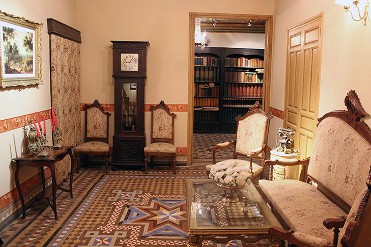

C/ Rosario, 1
30180 BULLAS
Telephone: +34 968 657 211
The "Don Pepe Marsilla House Museum. Bullas 1900" seeks to rescue an important part of the local culture of Bullas, recreating the living ways at the beginning of the 20th century. It also wants to preserve the town's historical heritage represented in this building.
The visit to this House Museum is placed within the Bullas Wine Route, the set of resources which organizes the tourist offer in the municipality around its identity sign, the wine, but also covering other monumental, historical, cultural and natural attractions.
The visit to this House Museum is placed within the Bullas Wine Route, the set of resources which organizes the tourist offer in the municipality around its identity sign, the wine, but also covering other monumental, historical, cultural and natural attractions.
Bullas 1900
Time has stopped in 1900 in this old noble house located in Bullas - Rosario street, just behind the parish church. It belonged to Don José Marsilla Melgares de Aguilar (1854 - 1930), commonly known as Don Pepe, who was a rich and powerful landowner but also mayor of Bullas twice.
The living area
Don Pepe's House shows the ostentatious way of life of the local landowners at the beginning of the 20th century. This fact can be noticed in the library, the living room, the dining room and the bedrooms. The decoration of this noble part of the building is marked by the Modern Style, the main one in Spain and Europe in those years which is characterized by an inspiration in nature, the use of curved lines and the figures stylization.
The working area
This wide part of the building is a faithful image of the economic activity developed in those years in Bullas as it is the place where the different works and tasks to process the huge productions of Don Pepe's properties took place.
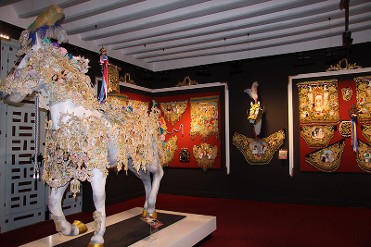
C/ Gregorio Javier, 21
30400 CARAVACA DE LA CRUZ
Telephone: 868 185 096
This space dedicated to the Caballos del Vino (Wine Horses) is located in the old house of the family Muso Muñoz Melgarejo, from the 18th century, which has been totally restored. It is a journey through its origins until the present, where all aspects of the festivity are represented: the bareback horses, the design, embroidery and piece of harnessing, the Race...
The aim is to proudly transmit and spread, through several rooms and audiovisuals, the roots and the present situation of a celebration that is currently a Intangible Cultural Heritage.
Telephones:
Reservas: 968 705 620
Museo: 868 185 096

Cuesta del Castillo, s/n. Iglesia de la Soledad
30400 CARAVACA DE LA CRUZ
Telephone: +34 968 700 512
The church was built in the location of the primitive church of El Salvador. It was built in the second third of the 17th century under the name of La Soledad, thanks to the patronage of Mr Pedro Muñoz Otálora, the senior lieutenant of the town. The church was designed and built by the master Juan Garzón Soriano, with the intervention of the local carpenter Sebastian de la Iglesia. Since the late 17th century, it became part of the primogeniture of the Muñoz family. During the 18th and 19th century it went to the Counts of Clavijo and Marquises of El Salar due to marriage covenants and inheritance divisions.
The Archaeological Museum is a first-rate equipment located in the historic city centre. It collects pieces of great value, as a result of the many findings in the excavations at several archaeological sites, especially those carried out in the Iberian-Roman complex of La Encarnación. In this museum we can find pottery, weapons, coins, architectural elements, etc.
Telephones:
Bookings: 968 705 620
Museum: 968 700 512
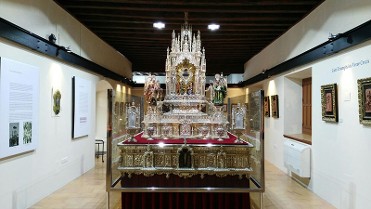
Castillo, Santuario de la Vera Cruz
30400 CARAVACA DE LA CRUZ
Telephone: +34 968 70 56 20
The building consists of two perpendicular naves preceded by a double gallery with semicircular lowered arches. It was designed during the first half of the 17th century.
The museum has also a collection of metal works and paintings. Inside the art gallery stand out 6 oil paintings on panel painting from the 16th century. These are original works of Hernando de los Llanos, a painter who was a disciple of Leonardo da Vinci. Another work worthy of mentioning is the oil on canvas Curación de Tobias (the healing of Tobias), made by Rafael Tegeo from Caravaca, who was a personal painter of Queen Isabel II and one of the best Spanish neoclassical portraitist from the 19th century.
In the metalwork section we can find the artwork Custiodia-Ostensorio de la Cruz (The Custody-Hostensory of the Cross) from the beginning of the 16th century; the artwork Portacruz de los Baños, a present from Luis Fajardo, the second Marquis of Velez; and the silver gilt box, donated towards the end of the 14th century by the master of the Order of Santiago, Lorenzo Suárez de Figueroa.
Standing as an important piece in the museum, La Casulla de Chirinos, a Muslim tiraz adapted to the shape of liturgical ornament, is believed to have been carried by priest Chirinos at the time of the miraculous apparition of the Cross.
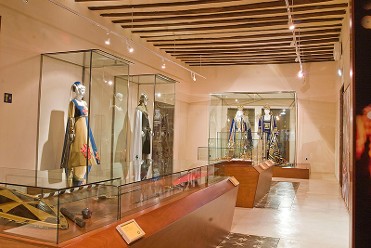
C/ Las Monjas, 19
30400 CARAVACA DE LA CRUZ
Telephone: +34 968 70 56 20
De moros o de cristianos. Así se visten los caravaqueños en festejos tan señalados como los que se organizan en honor de la Santísima y Vera Cruz, del 1 al 5 de mayo. Y estos trajes es precisamente lo que enseña al visitante este museo, aparte de los atalajes con los que se enjaezan a los Caballos del Vino el 2 de mayo.
El edificio, que data del siglo XVI, ha pertenecido a varios caravaqueños ilustres. Primero lo fue de don Luis de Mora, posteriormente, de la familia Uribe hasta que finalmente llegó a manos del Marqués de San Mamés.
Casa catalogada como "Protegida", fue Palacete del Marqués de los Uribe.
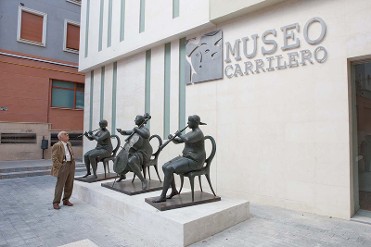
Pza. José Carrilero, s/n
30400 CARAVACA DE LA CRUZ
Telephone: +34 968 70 56 20
The monographic museum dedicated to the sculptor José Carrilero’s work is located in the square that carries his name. It takes up the rears and vaults from a former palatial home built in the second quarter of the 17th century by Don Luis de Gadea Sahajosa, councilor of Caravaca
The building: During the 18th and 19th centuries, the property belonged to a branch of the family Muñoz de Otálora and their heirs the Marquises of San Mamés de Arás, until it was acquired by other individuals. During some time in the 20th century, the building was leased as a Civil Guard Barracks House.
The exposition: The museum takes up an area of about 650 square meters and it is home to 90 works in total, including sculptures, paintings and medals. It consists of four exhibition halls, a multipurpose room and other service facilities.
In the first, second and third floor a representative sample of the painter’s work is exhibited. The exhibition highlights several sketches and figurative designs which later on became sculptural works.
The basement of the building, where the old vaulted wine cellars were situated, is almost entirely dedicated to the sculptural work of Carrilero. It contains 49 different sized bronze works and 14 sculptured and engraved medals.
Interesting feminine portrayals, academic torsos and unique relieves stand out in the building. The square and the façade of the museum exhibit an extraordinary group of sculptures of natural size, consisting of three instrumentalists, including the statue of a flutist, a cellist and a trumpeter. It’s a characteristic theme among the authors’ repertoire.
More information
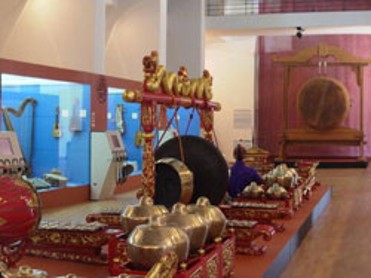
C/ Pedrera, s/n
30412 BARRANDA (CARAVACA DE LA CRUZ)
Telephone: +34 968 738 491
The museum is famous for its exoticism, variety and for the authenticity of its works. A great variety of cultures represented are spread out in 145 countries from all continents. The collection covers 4 categories of well-known musical instruments: chordophones, membranophones, idiophones and aerophones, depending on how the sound is produced and the materials of each instrument.
Within these classifications, the museum offers to its visitors a thematic exhibition about religions in the world as well as music instruments from slavery, magic and witchcraft. It also exhibits other themes which relate different fields of the human being to music.
The museum ethnical music also offers to its visitors a special section which pays tribute to Barranda and its Festivity of Cuadrillas.
The collection has been gathered by the ethno-musicologist Carlos Blanco Fadol, who has dedicated his life to the investigation and the gathering of the increasingly limited instruments from all corners of the world that are progressively disappearing because of the advent of new musical technologies.

Plaza del Castillo, s/n
30430 CEHEGÍN
Telephone: +34 968 74 25 25
It currently provides 12 exhibition rooms, as well as a library and an information room.
The museum consists of three buildings, two of which are historic ones.
One is the old Town Hall, the Palacio de los Fajardo, inaugurated in 1676 and whose main façade and outbuildings were built in 1745 on the annexes of the 12th century castle. The other building is located in Calle Mayor and corresponds to a smaller noble house from the 18th century. Between them, the three buildings have a total floor area of more than 2,800 square metres.
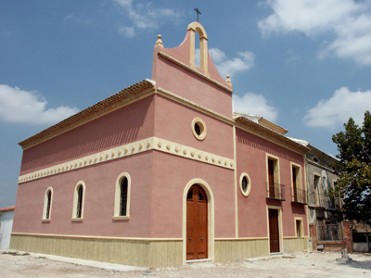
Pza. de la Ermita, s/n
30509 EL LLANO (MOLINA DE SEGURA)
Telephone: +34 968388519 / Fax: +34 968 692 019
Descripción
El conjunto museístico incluye una casa, una ermita, una noria y un huerto. La casa principal consta de dos plantas: en la planta baja se ubica la cocina, un amplio vestíbulo, con el tinajero y los chineros, la escalera y el antiguo patio, transformado en sala de usos múltiples. Se ha ambientado el mobiliario y el menaje típico de la época. En la planta primera está el dormitorio principal, ambientado como uno típico burgués del siglo XIX. Esta planta también acoge una muestra de indumentaria tradicional de los siglos XVIII y XIX. Asímismo, esta planta alberga un conjunto de miniaturas de útiles de la huerta e hidráulica tradicional, realizado por Juan de Dios Arnaldos, dedicadas a las tradiciones de la huerta y que contiene aperos de labranza, una recreación de la vida en una barraca huertana, la noria y una reproducción de las distintas formas de aprovechamiento de la fuerza hidráulica, como una fragua, un batán y un molino harinero.
Sólo accesible para discapacitados la planta baja del museo.
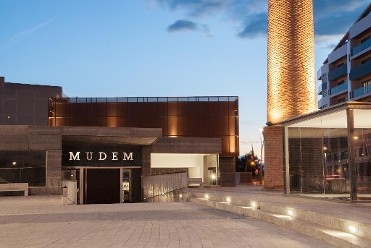
C/ Ibn Arabí s/n
30500 MOLINA DE SEGURA
Telephone: +34 968 38 85 62
El MUDEM es un espacio cultural museístico para proteger y difundir los restos rescatados en 2004 en la muralla de Molina de Segura, el hisn Mulina andalusí.
Un espacio con un enfoque lúdico e interactivo a la par que didáctico y reflexivo, que brinda la posibilidad de conocer mejor la historia de Molina de Segura en el contexto del antiguo Reino de Murcia.
Lugar accesible para discapacitados.
Teléfonos:
968 38 85 62
968 38 85 00 Ext. 2510.
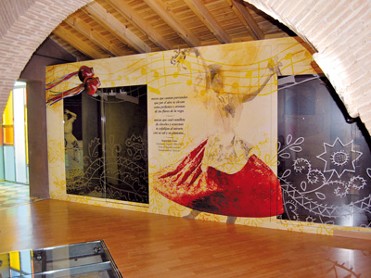
C/ Cid Campeador, 2 - Esquina calle del Castillo
30500 MOLINA DE SEGURA
Telephone: +34 968388519
El Museo se ubica en el popular barrio del Castillo, en una casa del siglo XVII-XVIII, claro ejemplo de arquitectura popular, con una estructura original, realizada con la antigua técnica del tapial. Destaca la impresionante cúpula del horno moruno, del que hay noticias desde 1491. El horno perteneció al Concejo de la villa en la Edad Media, antes de formar parte del marquesado de los Vélez y estuvo en funcionamiento hasta los años 70 del siglo XX.
Además de las labores del pan, el museo tiene una sección donde se muestra la música y bailes populares de Molina.
Lugar accesible para discapacitados.

Avd. de la Albarda, 74 - Pedanía La Albarda
30507 ALBARDA (MOLINA DE SEGURA)
Telephone: +34 968 388 522
El centro nos sumerge en las formas de vida ancestrales del campo de Molina. En la planta baja, conoceremos la diversidad geográfica y la vida tradicional, la intervención humana sobre el medio y cómo ésta ha conservado los ecosistemas. En la primera planta, hay una recreación de un aula de la antigua escuela, donde se realizan talleres el primer domingo de cada mes.
Sólo accesible para discapacitados la planta baja del edificio.
Teléfonos:
Concejalía de Turismo
968 388 522
968 388 523

C/ Doña Elvira, 4
30170 MULA
Telephone: +34 968 661 501
How much do you know about Mula? If it is not enough, the City of Mula Museum will teach you all you need to know about Mula culture, art and customs.
One of its permanet exhibitions is " El Legado de Mula en la Historia". In it , the visitor takes a tour around from prehistory to the recent history of the city. The pieces that can be seen just come from archaeological sites in Mula, whose collections were in The Archaeological Museum of Murcia .
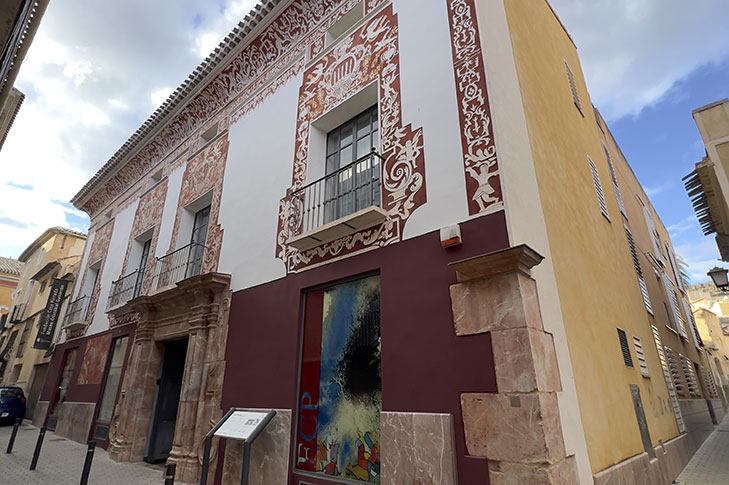
C/ San Francisco, 14
30170 MULA
Telephone: +34 968 661 551
Casa Pintada Foundation is a cultural project emerged and consolidated through Cristóbal Gabarrón Foundation and Mula Town Hall. It is placed in a XVIII century stately and emblasoned home known by its wonderful sgraffito as Casa Pintada. It shows Cristóbal Gabarrón´s career and, at the same time, it is a showcase of Murcian creativity.
This has made possible the return to Mula of one of the most internationally recognised artist whose purpose is to establish himself like a bastion in the Region culture and, at the same time, to be a reference of all the cultures coexisting in the Region.
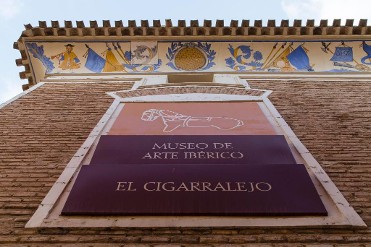
C/ Marqués, 1
30170 MULA
Telephone: +34 968 661 422
This museum located on Marqués street is an essential stop-off point of the historic quarter of Mula.
The Cigarralejo Museum of Iberian Art is established in the former palace of the Marquis of Menahermosa. It is a typical example of Murcian Baroque built in the 18th century. The facade has a cornise decorated with military paintings which represent the Marquis´profession. The interior of the building hosts ten halls which contain the most important art collection of Spain composed by more than 80 funerary offerings, pottery pieces, stone sculptures or weapons.
Museo Monográfico El Cigarralejo Brochure (2 Mb)


Av. Alfonso X "el Sabio", 7
30008 MURCIA
Telephone: +34 968 23 46 02
The Archaeological Museum is located in the House of Culture. At the beginning it was built as Provincial Palace of Archives, Libraries and Museums, thanks to the architects Luis Moya and José Luis León. It opened its doors in 1956. It is the best museum to know the most characteristic of regional archeology.
TIME: XX Century
STYLE: Historicist